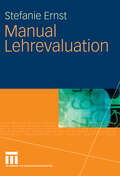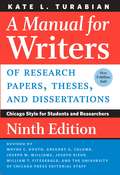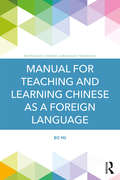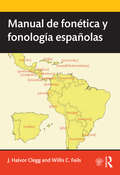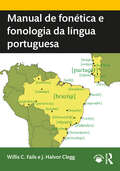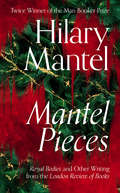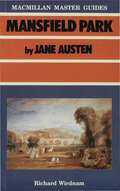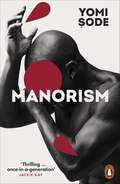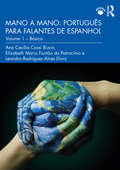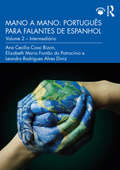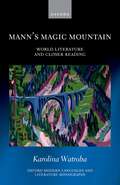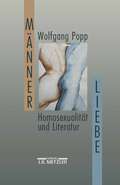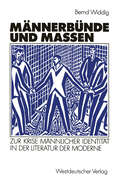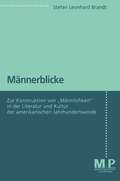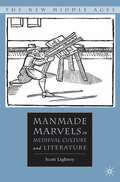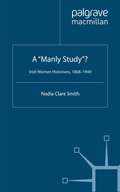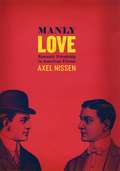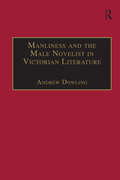- Table View
- List View
Manual Lehrevaluation
by Stefanie ErnstDas "Manual Lehrevaluation" bietet einen kompakten und gut nachvollziehbaren Einstieg in die Praxis der Evaluation im Hochschulbereich und leistet damit einen wichtigen Beitrag zu Qualitätssicherung und Qualitätsverbesserung in der Lehre.
A Manual for Writers of Research Papers, Theses, and Dissertations, Ninth Edition: Chicago Style for Students and Researchers (Chicago Guides to Writing, Editing, and Publishing)
by Kate L. TurabianWhen Kate L. Turabian first put her famous guidelines to paper, she could hardly have imagined the world in which today’s students would be conducting research. Yet while the ways in which we research and compose papers may have changed, the fundamentals remain the same: writers need to have a strong research question, construct an evidence-based argument, cite their sources, and structure their work in a logical way. A Manual for Writers of Research Papers, Theses, and Dissertations—also known as “Turabian”—remains one of the most popular books for writers because of its timeless focus on achieving these goals. This new edition filters decades of expertise into modern standards. While previous editions incorporated digital forms of research and writing, this edition goes even further to build information literacy, recognizing that most students will be doing their work largely or entirely online and on screens. Chapters include updated advice on finding, evaluating, and citing a wide range of digital sources and also recognize the evolving use of software for citation management, graphics, and paper format and submission. The ninth edition is fully aligned with the recently released Chicago Manual of Style, 17th edition, as well as with the latest edition of The Craft of Research. Teachers and users of the previous editions will recognize the familiar three-part structure. Part 1 covers every step of the research and writing process, including drafting and revising. Part 2 offers a comprehensive guide to Chicago’s two methods of source citation: notes-bibliography and author-date. Part 3 gets into matters of editorial style and the correct way to present quotations and visual material. A Manual for Writers also covers an issue familiar to writers of all levels: how to conquer the fear of tackling a major writing project. Through eight decades and millions of copies, A Manual for Writers has helped generations shape their ideas into compelling research papers. This new edition will continue to be the gold standard for college and graduate students in virtually all academic disciplines.
Manual for Teaching and Learning Chinese as a Foreign Language (Routledge Chinese Language Pedagogy)
by Bo HuWritten in an extended dictionary format, the Manual for Teaching and Learning Chinese as a Foreign Language aims to cover all key terms related to teaching Chinese as a foreign language. Each section contains an introduction with language-specific information, and identifies students and teachers’ common questions, including the capacity of Chinese as a morphologically unmarked language to indicate categories such as tense and mood. Many entries listed in this manual come with an explanation, a commentary, and rich examples. The Manual for Teaching and Learning Chinese as a Foreign Language appeals to both Chinese as a foreign language (CFL) teachers and students, as well as being the ideal reference for researchers conducting comparative studies of the Chinese and English languages.
Manual for Teaching and Learning Chinese as a Foreign Language (Routledge Chinese Language Pedagogy)
by Bo HuWritten in an extended dictionary format, the Manual for Teaching and Learning Chinese as a Foreign Language aims to cover all key terms related to teaching Chinese as a foreign language. Each section contains an introduction with language-specific information, and identifies students and teachers’ common questions, including the capacity of Chinese as a morphologically unmarked language to indicate categories such as tense and mood. Many entries listed in this manual come with an explanation, a commentary, and rich examples. The Manual for Teaching and Learning Chinese as a Foreign Language appeals to both Chinese as a foreign language (CFL) teachers and students, as well as being the ideal reference for researchers conducting comparative studies of the Chinese and English languages.
Manual de fonética y fonología españolas
by J. Halvor Clegg Willis C. FailsWritten entirely in Spanish, Manual de fonética y fonología españolas has a comprehensive scope that touches on all aspects of phonetics and phonology—including acoustic and auditory phonetics, phonotactics, and suprasegmentals, which most often remain untreated. The book provides students with a detailed and accurate yet accessible introduction to Spanish phonetics and phonology. It includes introductory chapters which place these disciplines within the general field of linguistics and which emphasize the role of sounds and their representation in human communication. Key features: Written by trained phoneticians and informed by the current science of phonetics. No prior knowledge of linguistics assumed, as a foundation is laid throughout for all linguistic terms and concepts. Each chapter contains a summary, a list of concepts and terminology, review questions, and pedagogically relevant pronunciation exercises keyed to the specific hints and suggestions provided in the chapters. Chapters dealing with the physical production of sounds contain sections with “Pedagogical Hints,” “Practical Suggestions,” and “Pronunciation Exercises” to link theory to the practical aspects of improving pronunciation. A wealth of graphic material to illustrate each concept clearly. Models of how to pronounce the sounds, sentences and exercises presented in the text, are available online at routledge.com/cw/clegg. Manual de fonética y fonología españolas is a comprehensive introduction designed to be clear and accessible to advanced students of Spanish to help them understand how to improve their pronunciation. It will serve as an excellent book for graduate students as well as a valuable resource for teachers, linguists and language professionals.
Manual de fonética y fonología españolas
by J. Halvor Clegg Willis C. FailsWritten entirely in Spanish, Manual de fonética y fonología españolas has a comprehensive scope that touches on all aspects of phonetics and phonology—including acoustic and auditory phonetics, phonotactics, and suprasegmentals, which most often remain untreated. The book provides students with a detailed and accurate yet accessible introduction to Spanish phonetics and phonology. It includes introductory chapters which place these disciplines within the general field of linguistics and which emphasize the role of sounds and their representation in human communication. Key features: Written by trained phoneticians and informed by the current science of phonetics. No prior knowledge of linguistics assumed, as a foundation is laid throughout for all linguistic terms and concepts. Each chapter contains a summary, a list of concepts and terminology, review questions, and pedagogically relevant pronunciation exercises keyed to the specific hints and suggestions provided in the chapters. Chapters dealing with the physical production of sounds contain sections with “Pedagogical Hints,” “Practical Suggestions,” and “Pronunciation Exercises” to link theory to the practical aspects of improving pronunciation. A wealth of graphic material to illustrate each concept clearly. Models of how to pronounce the sounds, sentences and exercises presented in the text, are available online at routledge.com/cw/clegg. Manual de fonética y fonología españolas is a comprehensive introduction designed to be clear and accessible to advanced students of Spanish to help them understand how to improve their pronunciation. It will serve as an excellent book for graduate students as well as a valuable resource for teachers, linguists and language professionals.
Manual de fonética e fonologia da língua portuguesa
by J. Halvor Clegg Willis C. FailsEscrito inteiramente em português, o Manual de fonética e fonologia da língua portuguesa é uma obra que abrange todos os aspectos fonéticos e fonológicos desse idioma, inclusive as questões de fonética acústica e auditiva, fonotática e traços suprassegmentais, que a maioria dos livros didáticos não aborda. Neste livro, o estudante encontrará uma introdução detalhada e exata, mas acessível, à fonética e à fonologia da língua portuguesa. Inclui capítulos introdutórios que contextualizam essas disciplinas no campo geral da linguística e salientam o papel dos sons e sua representação na comunicação humana. Principais características: ● Escrito por fonetistas qualificados e versados nas questões atuais da ciência fonética. ● Não é preciso já saber linguística, pois o livro expõe todos os termos e conceitos linguísticos necessários. ● Cada capítulo conta com um resumo, uma lista de conceitos e termos, perguntas de revisão e exercícios de pronúncia relevantes destinados à prática dos conselhos e sugestões específicos do capítulo. ● Os capítulos que abordam a produção física dos sons contêm seções de "Dicas Pedagógicas", "Conselhos Práticos" e "Exercícios de Pronúncia" que ligam a teoria aos aspectos práticos da boa pronúncia. ● Uma característica exclusiva deste livro é a exposição da fonética e fonologia das três principais normas cultas da língua portuguesa: a de São Paulo e do Rio de Janeiro para o português brasileiro (PB), e a de Lisboa para o português europeu (PE). ● Numerosas imagens, gráficos e tabelas para ilustrar claramente cada conceito. ● Recursos eletrônicos, disponíveis online nos materiais de eResource, com a pronúncia dos sons, frases e exercícios do livro. O Manual de fonética e fonologia da língua portuguesa é uma introdução abrangente a esses campos, escrita de modo a ser clara e acessível aos estudantes de português em nível avançado, para ajudá-los a entender como melhorar a própria pronúncia. O livro é excelente também tanto para alunos de pós-graduação, como para professores, linguistas e profissionais de letras. Written entirely in Portuguese, Manual de fonética e fonologia da língua portuguesa presents an accurate yet accessible introduction to Portuguese phonetics and phonology. The book covers all phonetic and phonological aspects of the language, including those often missing from other textbooks, such as acoustic and auditory phonetics, phonotactics, and suprasegmentals. The book maintains a careful balance between the theoretical and practical aspects of the topic and is designed to help learners improve their pronunciation through an understanding of the linguistic principles of phonetics and phonology combined with the application of these principles through exercises and practice. Additional pronunciation resources are available online at www.routledge.com/9780367179915. Written in a clear and accessible manner, the book is ideal for advanced students of Portuguese with no prior knowledge of linguistics.
Mantel Pieces: Royal Bodies And Other Writing From The London Review Of Books
by Hilary MantelA stunning collection of essays and memoir from twice Booker Prize winner and international bestseller Hilary Mantel, author of The Mirror and the Light
Mansfield Park by Jane Austen (Bloomsbury Master Guides)
by Richard WirdnamThis ebook is now available from Bloomsbury Academic. Bloomsbury Academic publish acclaimed resources for undergraduate and postgraduate courses across a broad range of subjects including Art & Visual Culture, Biblical Studies, Business & Management, Drama & Performance Studies, Economics, Education, Film & Media, History, Linguistics, Literary Studies, Philosophy, Politics & International Relations, Religious Studies, Social Work & Social Welfare, Study Skills and Theology. Visit bloomsbury.com for more information.
Manorism
by Yomi SodeSHORTLISTED FOR THE 2022 T. S. ELIOT PRIZESHORTLISTED FOR THE 2023 RATHBONES FOLIO PRIZEA GUARDIAN AND FINANCIAL TIMES BOOK OF THE YEAR 'A wonder of a collection' Caleb Azumah Nelson'Thrilling ... once-in-a-generation' Jackie Kay'Genius ... tells a thousand stories in stunningly crafted verse' Nikita Gill'Remarkable, textured ... Yomi Sode is a beautiful storyteller' Candice Carty-Williams'Heartbreaking ... This debut is the living heart and soul of contemporary poetry' Pascale Petit'Vivid, beautiful and deeply moving' Rt Hon Diane Abbott MP'Yomi Sode writes with clarity, anger and love' Andrew Graham-Dixon'Searing, shimmering, brilliant' Yrsa Daley-Ward'A must for all lovers of poetry and its power' Roger Robinson'Manorism is a classic' Caleb FemiImpassioned, insightful, electric, Manorism is a poetic examination of the lives of Black British men and boys: propped up and hemmed in by contemporary masculinity, deepened by family, misrepresented in the media, and complicated by the riches, and the costs, of belonging and inheritance. It is also an exploration of the differences of impunity afforded to white and Black people, and to white and Black artists.Caravaggio - originally, unexpectedly - looms large: as a man who moved between spheres of exalted patronage and petty criminality; as a painter who, amid the elegant conventions of late Mannerism, forged his own style of visceral dark and light; and as an individual whose recognized genius was allowed to legitimate and excuse his violence.In this profound and moving debut, Yomi Sode asks: what does it mean to find oneself between worlds - to 'code-switch', adapting one's speech and manners to widely differing cultural contexts? Who is, and who isn't, allowed to be more than their origins? And what do we owe each other? What do we owe ourselves?
The Manor House
by Jane Holland'I absolutely love this book from start to finish...a really atmospheric read, and brilliant characters.' NetGalley Reader, *****1963. When Eleanor meets famous young poet, Lyndon Chance, he offers a way to flee her abusive father. In return, she must pretend to be Lyndon's wife. He takes her home to a Tudor manor on the Camel Estuary in Cornwall, where she finds herself in the middle of a feud between Lyndon and his twin brother, Oliver. It's soon clear that the old house hides many dark secrets. But could they be a threat to Eleanor?Now. Taylor has come to idyllic Cornwall to research for her Master's thesis, combining her love for conservation with a personal interest in Chance's poetry. Haunted by her own tragic past, Taylor finds Chance's notoriety fascinating. If only the poet's grandson, Julius, wasn't so determined to thwart her attempts to uncover his family secrets. As Eleanor realises she's out of her depth at Estuary House, drawn to Lyndon like a moth to a flame, Taylor and Julius must fight their own attraction - but could shadows from the past tear them all apart?A stunning and richly evocative timeslip, perfect for fans of Lucinda Riley, Santa Montefiore and Kate Morton.
Mano a Mano: Volume 1 – Básico (Mano a mano: português para falantes de espanhol)
by Ana Cecília Cossi Bizon Elizabeth Maria Fontão do Patrocínio Leandro Rodrigues Alves DinizMano a Mano: Português para Falantes de Espanhol vem preencher uma importante lacuna no mercado editorial: a carência de livros didáticos que, considerando as necessidades específicas de falantes de espanhol, favoreçam um desenvolvimento mais rápido de sua proficiência em português. A coleção reúne uma série de características favoráveis à aprendizagem do português em diferentes contextos (ensino médio, universidades, cursos livres): Convida o(a) aluno(a) a desenvolver sua proficiência em português ao mesmo tempo que forma uma imagem multifacetada do Brasil, em diálogo com suas próprias construções culturais, desconstruindo discursos estabilizados e ampliando seus horizontes; Favorece o trânsito por múltiplas práticas de letramento, em que circulam diferentes gêneros discursivos, oferecendo oportunidades para que o(a) estudante aprimore suas capacidades de linguagem em contextos reais, ou próximos a situações autênticas de interação; Sensibiliza o(a) aluno(a) para diferentes variedades da língua portuguesa; Permite ao(à) estudante desenvolver suas capacidades léxico-gramaticais e fonético-fonológicas de maneira reflexiva e contextualizada, levando em consideração necessidades específicas de falantes de espanhol; Propõe tarefas semelhantes às encontradas no Certificado de Proficiência em Língua Portuguesa para Estrangeiros (Celpe-Bras), do Ministério da Educação brasileiro; É acompanhado por dois cadernos complementares integrados, com explicações detalhadas referentes a recursos léxico-gramaticais e fonético-fonológicos, além de uma série de atividades; Disponibiliza online os vídeos e áudios de tarefas de compreensão oral e de atividades de pronúncia. Preparado para o desenvolvimento de um curso de até 60 horas em contexto de imersão, ou 90 horas de não-imersão, Mano a Mano, Volume 1 – Básico permite levar falantes de espanhol (como língua materna ou estrangeira/adicional) que nunca tiveram contato significativo prévio com o português até o início do nível Intermediário do Celpe-Bras, do B1 do Quadro Europeu Comum de Referência para as Línguas, ou do Intermediário Médio do American Council on the Teaching of Foreign Languages.
Mano a Mano: Volume 1 – Básico (Mano a mano: português para falantes de espanhol)
by Ana Cecília Cossi Bizon Elizabeth Maria Fontão do Patrocínio Leandro Rodrigues Alves DinizMano a Mano: Português para Falantes de Espanhol vem preencher uma importante lacuna no mercado editorial: a carência de livros didáticos que, considerando as necessidades específicas de falantes de espanhol, favoreçam um desenvolvimento mais rápido de sua proficiência em português. A coleção reúne uma série de características favoráveis à aprendizagem do português em diferentes contextos (ensino médio, universidades, cursos livres): Convida o(a) aluno(a) a desenvolver sua proficiência em português ao mesmo tempo que forma uma imagem multifacetada do Brasil, em diálogo com suas próprias construções culturais, desconstruindo discursos estabilizados e ampliando seus horizontes; Favorece o trânsito por múltiplas práticas de letramento, em que circulam diferentes gêneros discursivos, oferecendo oportunidades para que o(a) estudante aprimore suas capacidades de linguagem em contextos reais, ou próximos a situações autênticas de interação; Sensibiliza o(a) aluno(a) para diferentes variedades da língua portuguesa; Permite ao(à) estudante desenvolver suas capacidades léxico-gramaticais e fonético-fonológicas de maneira reflexiva e contextualizada, levando em consideração necessidades específicas de falantes de espanhol; Propõe tarefas semelhantes às encontradas no Certificado de Proficiência em Língua Portuguesa para Estrangeiros (Celpe-Bras), do Ministério da Educação brasileiro; É acompanhado por dois cadernos complementares integrados, com explicações detalhadas referentes a recursos léxico-gramaticais e fonético-fonológicos, além de uma série de atividades; Disponibiliza online os vídeos e áudios de tarefas de compreensão oral e de atividades de pronúncia. Preparado para o desenvolvimento de um curso de até 60 horas em contexto de imersão, ou 90 horas de não-imersão, Mano a Mano, Volume 1 – Básico permite levar falantes de espanhol (como língua materna ou estrangeira/adicional) que nunca tiveram contato significativo prévio com o português até o início do nível Intermediário do Celpe-Bras, do B1 do Quadro Europeu Comum de Referência para as Línguas, ou do Intermediário Médio do American Council on the Teaching of Foreign Languages.
Mano a Mano: Volume 2 – Intermediário (Mano a mano: português para falantes de espanhol)
by Ana Cecília Cossi Bizon Elizabeth Maria Fontão do Patrocínio Leandro Rodrigues Alves DinizMano a Mano: Português para Falantes de Espanhol vem preencher uma importante lacuna no mercado editorial: a carência de livros didáticos que, considerando as necessidades específicas de falantes de espanhol, favoreçam um desenvolvimento mais rápido de sua proficiência em português. A coleção reúne uma série de características favoráveis à aprendizagem do português em diferentes contextos (ensino médio, universidades, cursos livres): Convida o(a) aluno(a) a desenvolver sua proficiência em português ao mesmo tempo em que forma uma imagem multifacetada do Brasil, em diálogo com suas próprias construções culturais, desconstruindo discursos estabilizados e ampliando seus horizontes; Favorece o trânsito por múltiplas práticas de letramento, em que circulam diferentes gêneros discursivos, oferecendo oportunidades para que o(a) estudante aprimore suas capacidades de linguagem em contextos reais, ou próximos a situações autênticas de interação; Sensibiliza o(a) aluno(a) para diferentes variedades da língua portuguesa; Permite ao(à) estudante desenvolver suas capacidades léxico-gramaticais e fonético-fonológicas de maneira reflexiva e contextualizada, levando em consideração necessidades específicas de falantes de espanhol; Propõe tarefas semelhantes às encontradas no Certificado de Proficiência em Língua Portuguesa para Estrangeiros (Celpe-Bras), do Ministério da Educação brasileiro; É acompanhado por dois cadernos complementares integrados, com explicações detalhadas referentes a recursos léxico-gramaticais e fonético-fonológicos, além de uma série de atividades; Disponibiliza online os vídeos e áudios de tarefas de compreensão oral e de atividades de pronúncia. Preparado para o desenvolvimento de um curso de até 60 horas em contexto de imersão, ou 90 horas em contexto de não-imersão, Mano a Mano, Volume 2 – Intermediário permite levar falantes de espanhol (como língua materna ou estrangeira/adicional) do início do Intermediário Superior do Celpe-Bras, do início do B1 ao início do B2 do Quadro Europeu Comum de Referência para as Línguas, ou do início do Intermediário Médio ao início do Avançado Médio na escala do American Council on the Teaching of Foreign Languages.
Mano a Mano: Volume 2 – Intermediário (Mano a mano: português para falantes de espanhol)
by Ana Cecília Cossi Bizon Elizabeth Maria Fontão do Patrocínio Leandro Rodrigues Alves DinizMano a Mano: Português para Falantes de Espanhol vem preencher uma importante lacuna no mercado editorial: a carência de livros didáticos que, considerando as necessidades específicas de falantes de espanhol, favoreçam um desenvolvimento mais rápido de sua proficiência em português. A coleção reúne uma série de características favoráveis à aprendizagem do português em diferentes contextos (ensino médio, universidades, cursos livres): Convida o(a) aluno(a) a desenvolver sua proficiência em português ao mesmo tempo em que forma uma imagem multifacetada do Brasil, em diálogo com suas próprias construções culturais, desconstruindo discursos estabilizados e ampliando seus horizontes; Favorece o trânsito por múltiplas práticas de letramento, em que circulam diferentes gêneros discursivos, oferecendo oportunidades para que o(a) estudante aprimore suas capacidades de linguagem em contextos reais, ou próximos a situações autênticas de interação; Sensibiliza o(a) aluno(a) para diferentes variedades da língua portuguesa; Permite ao(à) estudante desenvolver suas capacidades léxico-gramaticais e fonético-fonológicas de maneira reflexiva e contextualizada, levando em consideração necessidades específicas de falantes de espanhol; Propõe tarefas semelhantes às encontradas no Certificado de Proficiência em Língua Portuguesa para Estrangeiros (Celpe-Bras), do Ministério da Educação brasileiro; É acompanhado por dois cadernos complementares integrados, com explicações detalhadas referentes a recursos léxico-gramaticais e fonético-fonológicos, além de uma série de atividades; Disponibiliza online os vídeos e áudios de tarefas de compreensão oral e de atividades de pronúncia. Preparado para o desenvolvimento de um curso de até 60 horas em contexto de imersão, ou 90 horas em contexto de não-imersão, Mano a Mano, Volume 2 – Intermediário permite levar falantes de espanhol (como língua materna ou estrangeira/adicional) do início do Intermediário Superior do Celpe-Bras, do início do B1 ao início do B2 do Quadro Europeu Comum de Referência para as Línguas, ou do início do Intermediário Médio ao início do Avançado Médio na escala do American Council on the Teaching of Foreign Languages.
Mann's Magic Mountain: World Literature and Closer Reading (Oxford Modern Languages and Literature Monographs)
by Karolina WatrobaThis is the first study of Thomas Mann's landmark German modernist novel Der Zauberberg (The Magic Mountain, 1924) that takes as its starting point the interest in Mann's book shown by non-academic readers. It is also a case study in a cluster of issues central to the interrelated fields of transnational German studies, global modernism studies, comparative literature, and reception theory: it addresses the global circulation of German modernism, popular afterlives of a canonical work, access to cultural participation, relationship between so-called 'high-brow' and 'low-brow' culture, and the limitations of traditional academic reading practices. The study intervenes in these discussions by developing a critical practice termed 'closer reading' and positioning it within the framework of world literature studies. Mann's Magic Mountain centres around nine comparative readings of five novels, three films, and one short story conceived as responses to The Magic Mountain. These works provide access to distinct readings of Mann's text on three levels: they function as records of their authors' reading of Mann, provide insights into broader culturally and historically specific interpretations of the novel, and feature portrayals of fictional readers of The Magic Mountain. These nine case studies are contextualized, complemented, enhanced, and expanded through references to hundreds of other diverse sources that testify to a lively engagement with The Magic Mountain outside of academic scholarship, including journalistic reviews, discussions on internet fora and blogs, personal essays and memoirs, Mann's fan mail and his replies to it, publishing advertisements, and marketing brochures from Davos, where the novel is set.
Mann's Magic Mountain: World Literature and Closer Reading (Oxford Modern Languages and Literature Monographs)
by Karolina WatrobaThis is the first study of Thomas Mann's landmark German modernist novel Der Zauberberg (The Magic Mountain, 1924) that takes as its starting point the interest in Mann's book shown by non-academic readers. It is also a case study in a cluster of issues central to the interrelated fields of transnational German studies, global modernism studies, comparative literature, and reception theory: it addresses the global circulation of German modernism, popular afterlives of a canonical work, access to cultural participation, relationship between so-called 'high-brow' and 'low-brow' culture, and the limitations of traditional academic reading practices. The study intervenes in these discussions by developing a critical practice termed 'closer reading' and positioning it within the framework of world literature studies. Mann's Magic Mountain centres around nine comparative readings of five novels, three films, and one short story conceived as responses to The Magic Mountain. These works provide access to distinct readings of Mann's text on three levels: they function as records of their authors' reading of Mann, provide insights into broader culturally and historically specific interpretations of the novel, and feature portrayals of fictional readers of The Magic Mountain. These nine case studies are contextualized, complemented, enhanced, and expanded through references to hundreds of other diverse sources that testify to a lively engagement with The Magic Mountain outside of academic scholarship, including journalistic reviews, discussions on internet fora and blogs, personal essays and memoirs, Mann's fan mail and his replies to it, publishing advertisements, and marketing brochures from Davos, where the novel is set.
Männerbünde und Massen: Zur Krise männlicher Identität in der Literatur der Moderne
by Bernd WiddigSeit Beginn des frühen zwanzigsten Jahrhunderts beschäftigt Psychologen, Philosophen und Schriftsteller die Frage: Wie verhält sich der Einzelne gegenüber dem Phänomen der Massen?Dieses Buch zeigt, daß sich sowohl die fiktionale Beschreibung als auch die theoretische Erklärung von Massenerscheinungen in einem Geschlechter-Diskurs vollzieht,der zwei Seiten hat. Während die Masse - bedrohlich und zugleich faszinierend - als weiblich beschrieben wird, entspinnt sich als Alternative zur Massengesellschaft die Vorstellung von einer Gesellschaft und Kultur, die sich auf dem exklusiven Band der Freundschaft und Liebe zwischen Männern gründet.Untersucht werden unter anderem Texte von Thomas Mann, Hans Blüher, Max Weber, Bruno Frank, Sigmund Freud, Alfred Döblin, Elias Canetti und Otto Weininger.
Männerblicke: Zur Konstruktion von "Männlichkeit" in der Literatur und Kultur der amerikanischen Jahrhundertwende (1890-1914)
by Stefan Leonhard BrandtManmade Marvels in Medieval Culture and Literature (The New Middle Ages)
by S. LightseyThis book examines marvels as tangible objects in the literary, courtly, and artisanal cultures of medieval England, but these clever devices, neither wholly semiotic nor purely positivist objects, are imbued with diverse cultural significance that illuminates in new ways the familiar literature of the Ricardian period.
A 'Manly Study'?: Irish Women Historians 1868-1949
by N. SmithThis book explores the lives, careers, and social and political activism of a diverse group of women historians in Ireland, contributing to the study of the Irish historical tradition and the study of women historians in an international context. It addresses debates about gender and history, modern Irish historiography and Irish women's history.
Manly Love: Romantic Friendship in American Fiction
by Axel NissenThe modern idea of Victorians is that they were emotionless prudes, imprisoned by sexual repression and suffocating social constraints; they expressed love and affection only within the bounds of matrimony—if at all. And yet, a wealth of evidence contradicting this idea has been hiding in plain sight for close to a century. In Manly Love, Axel Nissen turns to the novels and short stories of Victorian America to uncover the widely overlooked phenomenon of passionate friendships between men. Nissen’s examination of the literature of the period brings to light a forgotten genre: the fiction of romantic friendship. Delving into works by Mark Twain, Henry James, William Dean Howells, and others, Nissen identifies the genre’s unique features and explores the connections between romantic friendships in literature and in real life. Situating love between men at the heart of Victorian culture, Nissen radically alters our understanding of the American literary canon. And with its deep insights into the emotional and intellectual life of the period, Manly Love also offers a fresh perspective on nineteenth-century America’s attitudes toward love, friendship, marriage, and sex.
Manly Love: Romantic Friendship in American Fiction
by Axel NissenThe modern idea of Victorians is that they were emotionless prudes, imprisoned by sexual repression and suffocating social constraints; they expressed love and affection only within the bounds of matrimony—if at all. And yet, a wealth of evidence contradicting this idea has been hiding in plain sight for close to a century. In Manly Love, Axel Nissen turns to the novels and short stories of Victorian America to uncover the widely overlooked phenomenon of passionate friendships between men. Nissen’s examination of the literature of the period brings to light a forgotten genre: the fiction of romantic friendship. Delving into works by Mark Twain, Henry James, William Dean Howells, and others, Nissen identifies the genre’s unique features and explores the connections between romantic friendships in literature and in real life. Situating love between men at the heart of Victorian culture, Nissen radically alters our understanding of the American literary canon. And with its deep insights into the emotional and intellectual life of the period, Manly Love also offers a fresh perspective on nineteenth-century America’s attitudes toward love, friendship, marriage, and sex.
Manliness and the Male Novelist in Victorian Literature (The Nineteenth Century Series)
by Andrew DowlingThe purpose of this book is to address two principal questions: 'Was the concept of masculinity a topic of debate for the Victorians?' and 'Why is Victorian literature full of images of male deviance when Victorian masculinity is defined by discipline?' In his introduction, Dowling defines Victorian masculinity in terms of discipline. He then addresses the central question of why an official ideal of manly discipline in the nineteenth century co-existed with a literature that is full of images of male deviance. In answering this question, he develops a notion of 'hegemonic deviance', whereby a dominant ideal of masculinity defines itself by what it is not. Dowling goes on to examine the fear of effeminacy facing Victorian literary men and the strategies used to combat these fears by the nineteenth-century male novelist. In later chapters, concentrating on Dickens and Thackeray, he examines how the male novelist is defined against multiple images of unmanliness. These chapters illustrate the investment made by men in constructing male 'others', those sources of difference that are constantly produced and then crushed from within gender divide. By analysing how Victorian literary texts both reveal and reconcile historical anxieties about the meaning of manliness, Dowling argues that masculinity is a complex construction rather than a natural given.
